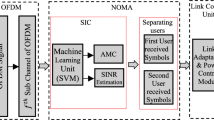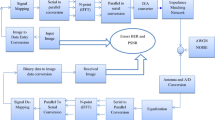Abstract
In this work, a 32-channel DWDM system has been evaluated by employing modified duobinary return to zero (MDRZ) and differential phase shift keying (DPSK) modulation techniques at alternate channels. Performance of the system has been evaluated in terms of gain, noise figure, optical signal-to-noise ratio (OSNR), quality- factor (Q-factor) and noise figure (NF). The DPSK modulated channels result in higher values of gain, OSNR and Q-factor with low noise figure values as compared to MDRZ channels. The reduction in FWM components have been reported in case of DPSK modulated channels and by employing erbium-ytterbium doped fiber amplifier (EYDFA). Further, Machine Learning (ML) techniques have been applied for gain spectrum and performance estimation. Levenberg–Marquardt's (LM) provides best fit as compared to other ANN models in case of gain spectrum estimation. The k-nearest neighbors (KNN) and support vector machine (SVM) algorithms have been tested for impairments analysis and performance estimation based on root mean square error (RMSE) and coefficient of determination (R2) as performance indicators. The best-performing model for gain, OSNR, Q-factor and NF are ANN-LM, KNN fine tree, KNN fine tree and SVM cubic, respectively.










Similar content being viewed by others
Data availability
The data that support the findings of this study are available from the corresponding author upon reasonable request.
References
S. Kaur, All optical data comparator and decoder using SOA-based Mach-Zehnder interferometer. Optik-Int. J. Light Electron Opt. 124(17), 2650–2653 (2013)
G.P. Agrawal, Fiber-optic communication systems. John Wiley & Sons (2012)
Anurupa, S. Kaur, Y. Malhotra, Performance evaluation and comparative study of novel high and flat gain C+ L band Raman+ EYDFA co-doped fibre hybrid optical amplifier with EYDFA only amplifier for 100 channels SD-WDM systems. Opt. Fiber Technol. 53, 102016 (2019)
A. Lubana, S. Kaur, FWM crosstalk reduction and performance investigation of SC-DWDM system employing ML techniques. Opt. Fiber Technol. 78, 103304 (2023)
K. Inoue, Four-wave mixing in an optical fiber in the zero-dispersion wavelength region. J. Lightwave Technol. 10(11), 1553–1561 (1992)
F. Ali et al., Modeling and minimization of FWM effects in DWDM-based long-haul optical communication systems. Photon Netw. Commun. 41, 36–46 (2021)
H.U. Manzoor et al., FWM mitigation in DWDM optical networks. J. Phys. Conf. Ser. (2020). https://doi.org/10.1088/1742-6596/1447/1/012033
F. Forghieri et al., Repeaterless transmission of eight channels at 10 Gb/s over 137 km (11 Tb/s-km) of dispersion-shifted fiber using unequal channel spacing. IEEE Photon. Technol. Lett. 6(11), 1374–1376 (1994)
S.P. Singh, S. Kar, V.K. Jain, Novel strategies for reducing FWM using modified repeated unequally spaced channel allocation. Fiber Integr. Opt. 23(6), 415–437 (2004)
G. Kumar, C. Kumar, Performance optimization of DPSK and QPSK for super dense wavelength division multiplexing system. Fluct. Noise Lett. 20(01), 2150005 (2021)
T. Sabapathi, R. Poovitha, Mitigation of nonlinearities in fiber optic DWDM system. Optik 185, 657–664 (2019)
B. Zhu, Advanced topics on Er-and ErYb-doped fibers for fiber amplifiers and lasers. Passive Comp. Fiber-based Dev. V. (2008). https://doi.org/10.1117/12.803368
Y. Zhang et al., Fast adaptation of multi-task meta-learning for optical performance monitoring. Opt. Express 31(14), 23183–23197 (2023)
S. Kulandaivel, R.K. Jeyachitra, Combined image Hough transform based simultaneous multi-parameter optical performance monitoring for intelligent optical networks. Opt. Fiber Technol. (2023). https://doi.org/10.1016/j.yofte.2023.103357
M.A. Amirabadi et al., Improving MDM–WDM optical network performance via optimized power allocation using Gaussian noise model. Opt. Fiber Technol. 75, 103187 (2023)
Y. Zhou et al., An artificial intelligence model based on multi-step feature engineering and deep attention network for optical network performance monitoring. Optik 273, 170443 (2023)
A. Masih, G. Kaur, Machine learning-based regression models for predicting signal quality of dense wavelength division multiplexing (DWDM) optical communication network. Int. J. Commun. Syst. (2023). https://doi.org/10.1002/dac.5518
S. Zhu, C.L. Gutterman, W. Mo, Y. Li, G. Zussman, and D.C. Kilper, Machine learning based prediction of erbium-doped fiber WDM line amplifier gain spectra. In European Conference on Optical Communication (ECOC), Rome, Italy (2018)
Y. You, Z. Jiang, and C. Janz, Machine learning-based EDFA gain model. In European Conference on Optical Communication (ECOC), Rome, Italy (2018)
M. Freire, S. Mansfeld, D. Amar, F. Gillet, A. Lavignotte, and C. Lepers, Predicting optical power excursions in erbium doped fiber amplifiers using neural networks. In Asia Communications Conference (ACP), Hangzhou, China (2018)
S. Zhu, C. Gutterman, A.D. Montiel, J. Yu, M. Ruffini, G. Zussman, and D. Kilper, Hybrid machine learning EDFA model. In Optical Fiber Communication Conference (OFC), San Diego, CA (2020)
M. Ionescu, Machine learning for ultrawide bandwidth amplifier configuration. In International Conference on Transparent Optical Networks (ICTON), Angers, France (2019)
A.M.R. Brusin, U.C. de Moura, V. Curri, D. Zibar, A. Carena, Introducing load aware neural networks for accurate predictions of Raman amplifiers. J. Lightwave Technol. 38, 6481–6491 (2020)
J. Mata, I. de Miguel, R.J. Durán, J.C. Aguado, N. Merayo, L. Ruiz, P. Fernández, R.M. Lorenzo, and E. J. Abril, A SVM approach for lightpath QoT estimation in optical transport networks. In IEEE BigData, Boston, MA, pp. 4795–4797(2017).
T. Panayiotou, S.P. Chatzis, G. Ellinas, Performance analysis of a data-driven quality-of-transmission decision approach on a dynamic multicast-capable metro optical network. J. Opt. Commun. Netw. 9, 98–108 (2017)
Funding
Not Applicable.
Author information
Authors and Affiliations
Contributions
All authors have contributed to the design of the proposed configuration. Anurupa performs the whole simulation work and prepares the manuscript. SK analysed, investigated, and supervised the findings of this work and contributes to the editing of the manuscript.
Corresponding author
Ethics declarations
Conflict of interest
The authors declare that this is their original work, and this paper has not been submitted to any other journals. The authors declare that they have no conflict of interest.
Additional information
Publisher's Note
Springer Nature remains neutral with regard to jurisdictional claims in published maps and institutional affiliations.
Rights and permissions
Springer Nature or its licensor (e.g. a society or other partner) holds exclusive rights to this article under a publishing agreement with the author(s) or other rightsholder(s); author self-archiving of the accepted manuscript version of this article is solely governed by the terms of such publishing agreement and applicable law.
About this article
Cite this article
Kaur, S., Lubana, A. Performance estimation of super combined DWDM system employing machine learning. J Opt (2024). https://doi.org/10.1007/s12596-024-01770-9
Received:
Accepted:
Published:
DOI: https://doi.org/10.1007/s12596-024-01770-9




